Gil-galad is a fictional character in J. R. R. Tolkien's Middle-earth legendarium, the last high king of the Noldor, one of the main divisions of Elves. He is mentioned in The Lord of the Rings, where the hobbit Sam Gamgee recites a fragment of a poem about him, and The Silmarillion. In the Last Alliance of Elves and Men, Gil-galad and Elendil laid siege to the Dark Lord Sauron's fortress of Barad-dûr, and fought him hand-to-hand for the One Ring. Gil-galad and Elendil were both killed, but Sauron was wounded. This allowed Elendil's son Isildur to cut the Ring from Sauron's hand, defeating Sauron, and to take the Ring for himself.
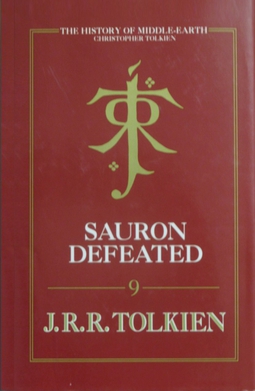
The History of Middle-earth is a 12-volume series of books published between 1983 and 1996 by George Allen & Unwin in the UK and by Houghton Mifflin in the US. They collect and analyse much of J. R. R. Tolkien's legendarium, compiled and edited by his son Christopher Tolkien. The series shows the development over time of Tolkien's conception of Middle-earth as a fictional place with its own peoples, languages, and history, from his earliest notions of "a mythology for England" through to the development of the stories that make up The Silmarillion and The Lord of the Rings. It is not a "history of Middle-earth" in the sense of being a chronicle of events in Middle-earth written from an in-universe perspective; it is instead an out-of-universe history of Tolkien's creative process. In 2000, the twelve volumes were republished in three limited edition omnibus volumes.

Bilbo's Last Song is a poem by J. R. R. Tolkien, written as a pendant to his fantasy The Lord of the Rings. It was first published in a Dutch translation in 1973, subsequently appearing in English on posters in 1974 and as a picture-book in 1990. It was illustrated by Pauline Baynes, and set to music by Donald Swann and Stephen Oliver. The poem's copyright was owned by Tolkien's secretary, to whom he gave it in gratitude for her work for him.
The Red Book of Westmarch is a fictional manuscript written by hobbits, related to the author J. R. R. Tolkien's frame stories. It is an instance of the found manuscript conceit, a literary device to explain the source of his legendarium. In the fiction, it is a collection of writings in which the events of The Hobbit and The Lord of the Rings were recounted by their characters, and from which Tolkien supposedly derived these and other works. The name of the book comes from its red leather binding and casing, and from its having been housed in the Westmarch, a region of Middle-earth next to the Shire.
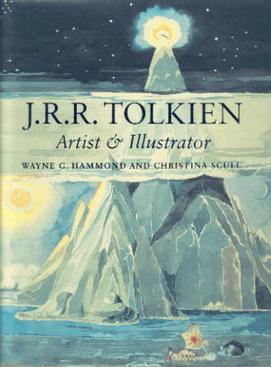
J. R. R. Tolkien: Artist and Illustrator is a collection of paintings and drawings by J. R. R. Tolkien for his stories, published posthumously in 1995. The book was edited by Wayne G. Hammond and Christina Scull. It won the 1996 Mythopoeic Scholarship Award for Inklings Studies. The nature and importance of Tolkien's artwork is discussed.

The Mythopoeic Awards for literature and literary studies are given annually for outstanding works in the fields of myth, fantasy, and the scholarly study of these areas. Established by the Mythopoeic Society in 1971, the Mythopoeic Fantasy Award is given for "fiction in the spirit of the Inklings", and the Scholarship Award for non-fiction work. The award is a statuette of a seated lion, with a plaque on the base. It has drawn resemblance to, and is often called, the "Aslan".
The following outline is provided as an overview of and topical guide to the real-world history and notable fictional elements of J. R. R. Tolkien's fantasy universe. It covers materials created by Tolkien; the works on his unpublished manuscripts, by his son Christopher Tolkien; and films, games and other media created by other people.
The works of J. R. R. Tolkien have generated a body of research covering many aspects of his fantasy writings. These encompass The Lord of the Rings and The Silmarillion, along with his legendarium that remained unpublished until after his death, and his constructed languages, especially the Elvish languages Quenya and Sindarin. Scholars from different disciplines have examined the linguistic and literary origins of Middle-earth, and have explored many aspects of his writings from Christianity to feminism and race.
Wayne Gordon Hammond is an American scholar known for his research and writings on the works of J. R. R. Tolkien. He has won five Mythopoeic Awards.
Christina Scull is a British researcher and writer best known for her books about the works of J. R. R. Tolkien, in collaboration with her husband Wayne G. Hammond who is also a Tolkien scholar. They have jointly won Mythopoeic Scholarship Awards for Inklings Studies five times.

Tolkien's Legendarium: Essays on The History of Middle-earth is a collection of scholarly essays edited by Verlyn Flieger and Carl F. Hostetter on the 12 volumes of The History of Middle-earth, relating to J. R. R. Tolkien's fiction and compiled and edited by his son, Christopher. It was published by Greenwood Press in 2000. That series comprises a substantial part of "Tolkien's legendarium", the body of Tolkien's mythopoeic writing that forms the background to his The Lord of the Rings and which Christopher Tolkien summarized in his construction of The Silmarillion.
Douglas Allen Anderson is an American writer and editor on the subjects of fantasy and medieval literature, specializing in textual analysis of the works of J. R. R. Tolkien. His 1988 edition of Tolkien's children's book The Hobbit, The Annotated Hobbit, won him a Mythopoeic Award for scholarship.
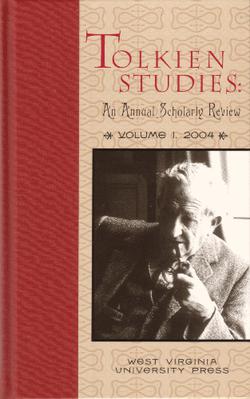
Tolkien Studies: An Annual Scholarly Review is an academic journal founded in 2004 publishing papers on the works of J. R. R. Tolkien. The journal's founding editors are Douglas A. Anderson, Michael D. C. Drout, and Verlyn Flieger, and the current editors are Michael D. C. Drout, Verlyn Flieger, and David Bratman. It states that it is the first scholarly journal published by an academic press in the area of Tolkien research.
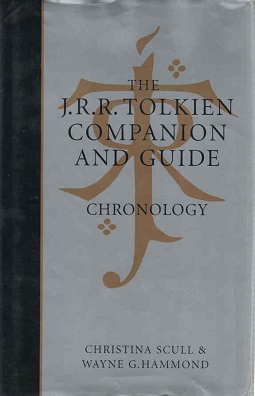
The J. R. R. Tolkien Companion and Guide is a 2006 reference book by the husband and wife team of Christina Scull and Wayne G. Hammond. It provides a detailed chronology of Tolkien's life in volume 1, and a reader's guide in volume 2. The second edition in 2017 revised and extended the work, the reader's guide being divided into two volumes.

The Letters of J. R. R. Tolkien is a selection of the philologist and fantasy author J. R. R. Tolkien's letters. It was published in 1981, edited by Tolkien's biographer Humphrey Carpenter, who was assisted by Christopher Tolkien. The selection, from a large mass of materials, contains 354 letters. These were written between October 1914, when Tolkien was an undergraduate at Oxford, and 29 August 1973, four days before his death. The letters are of interest both for what they show of Tolkien's life and for his interpretations of his Middle-earth writings.

Poems and Songs of Middle Earth is a studio album of spoken-word poetry by the English author J. R. R. Tolkien and art songs composed by the English musician Donald Swann. On the first half of the album, Tolkien recites seven poems from or related to his fantasy novel The Lord of the Rings (1954–55). The second half is a performance of Swann's song cycle The Road Goes Ever On, which sets selections from Tolkien's verse to music. The vocalist William Elvin sings The Road Goes Ever On to Swann's piano accompaniment. Caedmon Records issued the album on 18 October 1967 in the United States, and then on 28 March 1968 in the United Kingdom. Its release coincided with the publication of The Road Goes Ever On as a book of sheet music with commentary and illustration by Tolkien.

Tolkien's artwork was a key element of his creativity from the time when he began to write fiction. A professional philologist, J. R. R. Tolkien prepared a wide variety of materials to support his fiction, including illustrations for his Middle-earth fantasy books, facsimile artefacts, more or less "picturesque" maps, calligraphy, and sketches and paintings from life. Some of his artworks combined several of these elements.
"The Shadow of the Past" is the second chapter of J. R. R. Tolkien's bestselling fantasy work, The Lord of the Rings, which was published in 1954–1955. Tolkien called it "the crucial chapter"; the Tolkien scholar Tom Shippey labelled it "the vital chapter". This is because it represents both the moment that Tolkien devised the central plot of the book, and the point in the story where the protagonist, Frodo Baggins, and the reader realise that there will be a quest to destroy the Ring. A sketch of it was among the first parts of the book to be written, early in 1938; later that year, it was one of three chapters of the book that he drafted. In 1944, he returned to the chapter, adding descriptions of Gollum, the Ring, and the hunt for Gollum.
In J. R. R. Tolkien's epic fantasy The Lord of the Rings, an oliphaunt is a giant war elephant, used by the army of the Haradrim. Tolkien borrowed the word from Middle English to give a rustic feeling to Sam Gamgee's speech. The beasts are first mentioned by Sam as he explains to Gollum what an oliphaunt is; he hopes to see one. His wish is fulfilled as he witnesses Faramir's ambush of a contingent from Harad in Ithilien. Several mûmakil take part in the Battle of the Pelennor Fields.
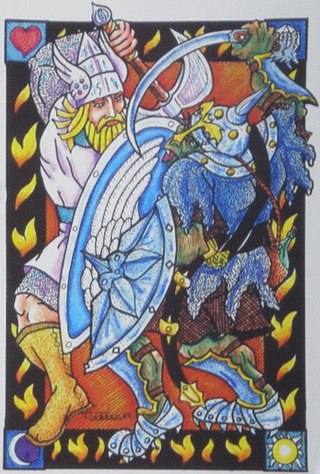
J. R. R. Tolkien invented heraldic devices for many of the characters and nations of Middle-earth. His descriptions were in simple English rather than in specific blazon. The emblems correspond in nature to their bearers, and their diversity contributes to the richly-detailed realism of his writings.












